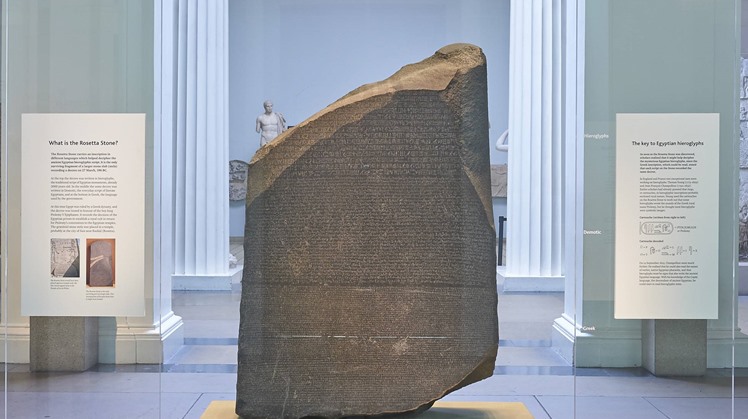When you visit the British Museum, you will find a part of our ancient Egyptian history, perhaps the most notable of which is the Rosetta Stone, which was discovered by Rosetta by chance by Napoleon's army, when they were digging for the construction of the foundation of a fort near the town of Rashid in the Nile Delta in July 1799, and after Napoleon's defeat, the The stone was brought to Britain under the terms of the Treaty of Alexandria in 1801 and other antiquities found by the French, and it was shipped to England and arrived at Portsmouth in February 1802, and soon it was displayed in the British Museum, but the stone was copied after that and placed in several museums, how many of those copies Did Champollion decipher the stone on copies or the original piece?
To find out the answers to these questions, we contacted the researcher of optics, Dr. Hussein Abdel Basir, director of the Bibliotheca Alexandrina Museum, who said: There are many copies of the Rosetta Stone, so we find a distinct copy in the Egyptian Museum in Tahrir, along with a copy found in the Museum of Antiquities of the Library of Alexandria Which was located in the Greco-Roman Museum, and its age exceeded 100 years, in addition to another copy in the Museum of Manuscripts in Alexandria, which are the recognized copies until now.
Dr. Hussein Abdel-Baseer pointed out that Champollion conducted his research to decipher the Rosetta Stone on copies of the images and not on the original piece in the British Museum. Studies were previously conducted on the stone by a number of scholars before sending copies to Champollion, namely Thomas Young, Ibn Wahshiyah. The Egyptian Nun, Athanasius Kircher, and research and study were conducted on these images.
From the beginning, Champollion was a lover of history and advanced his studies. He studied Oriental and Coptic languages at the hands of the great scholars of his time. He taught history for a period of time. Then he traveled to Paris to work as the first curator of the Egyptian collection at the Louvre Museum. He also held the position of Professor of Egyptian Antiquities at the Louvre Museum. "College de France", he developed a lexicon in the Coptic language.
He was able to decipher the ancient Egyptian language after using the Rosetta Stone, which was discovered during the French campaign against Egypt, which opened the door to understanding the ancient Egyptian civilization and knowing many of its secrets, and establishing Egyptology in the most prestigious universities in Europe.
Champollion's achievement of deciphering the ancient Egyptian language in 1822 was not an easy matter. It came as a result of patience and a long and exhausting search. He knew how to collect the flashes of light accomplished by Egyptologists before him into a colossal discovery.
Champollion's effort did not stop there, but he came to Egypt to continue his research and discoveries of the treasures of the Pharaonic civilization, and he lived in Egypt for a year and a half, during which he did not stop excavating for Pharaonic antiquities, as he conducted a systematic survey of the inscriptions, and the writings on the monuments, and put a book " Antiquities of Egypt and Nubia" about his observations in it.
When he returned to Paris, he was appointed to the position of professor of Egyptian antiquities, but he resigned, and devoted the rest of his life to developing a book of Egyptian grammar, which he was able to complete before his death in 1832.
 Thu, May. 26, 2022
Thu, May. 26, 2022